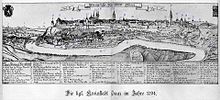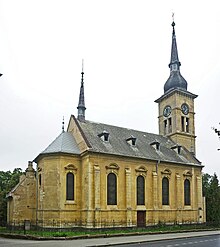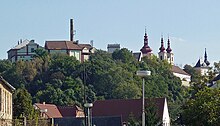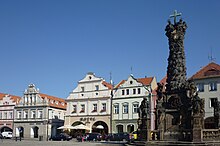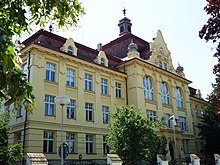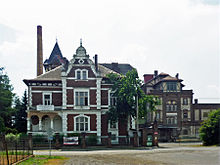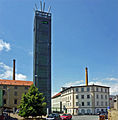Žatec
| Žatec | ||||
|---|---|---|---|---|
|
||||
| Basic data | ||||
| State : |
|
|||
| Historical part of the country : | Bohemia | |||
| Region : | Ústecký kraj | |||
| District : | Louny | |||
| Area : | 4268.7337 ha | |||
| Geographic location : | 50 ° 20 ' N , 13 ° 33' E | |||
| Height: | 233 m nm | |||
| Residents : | 19,133 (Jan 1, 2019) | |||
| Postal code : | 438 01 | |||
| License plate : | U | |||
| traffic | ||||
| Railway connection: | Prague – Chomutov | |||
| structure | ||||
| Status: | city | |||
| Districts: | 7th | |||
| administration | ||||
| Mayor : | Zdeňka Hamousová (as of November 2018) | |||
| Address: | náměstí Svobody 1 438 01 Žatec 1 |
|||
| Municipality number: | 566985 | |||
| Website : | www.mesto-zatec.cz | |||
| Location of Žatec in the Louny district | ||||
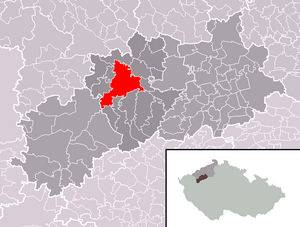
|
||||
Žatec (German Saaz ) is a town in Okres Louny (Laun district) in Ústecký kraj (Aussiger region) in northwestern Czech Republic . Under the Bohemian King Ottokar II Přemysl , it was declared a royal town in 1265 , was given special privileges and was the administrative center of the Saatz district until 1848 . In 1868 Saaz became the seat of the district administration of the Saaz district .
The historic city center was declared an urban monument reserve in 1961 . Žatec is the center of a traditional hop-growing region and, thanks to the hop trade, is important for the Czech and foreign brewing industry.
Geographical location
The city is located on the right bank of the Eger above the confluence of the Hutná , about 48 kilometers east-northeast of Karlovy Vary .
history
The fertile landscape of the Saaz Plain was inhabited from the earliest times. Prehistoric finds from this area, which are shown in the Saaz Regional Museum, prove this, they are pagan, without dating and are part of the history of Bohemia .
In historical sources it is first mentioned as (Latin) Urbs Satzi in the chronicle of Thietmar von Merseburg , when the German emperor liberated the Slavic castle from Polish occupation. The city was made a royal city in Bohemia in 1265 and was one of the most important administrative centers of the Kingdom of Bohemia in the Middle Ages. From the 15th century until the revolutionary year 1848 , Žatec was the seat of one of the 16, later 12, Bohemian districts . From 1714 to 1751 the neighboring Elbogen district ( Loketský kraj ) was attached to this Saatz district ( Žatecký kraj ) . From 1868 it had the status of a district town of the Saaz district in the Kingdom of Bohemia , from 1938 to 1945 of the Saaz district of the German Empire and from 1945 to 1960 of the Okres Žatec in Czechoslovakia .
Under the Bohemian King Ottokar I Přemysl , German settlers were called into the country from 1200 by locators who also settled in Saaz. After the attacks of the Czech reform movement of the Hussites around 1420, many Germans left the city again. Under the rule of George of Podebrady , the city confessed to Utraquism and was then essentially Evangelical-Lutheran until the Battle of the White Mountain (1620). As a participant in the Protestant uprising in Bohemia , Saaz mayor Maxmilián Hošťálek z Javořice (* 1564) was sentenced to death and executed in Prague in 1621. The city of Saaz lost numerous privileges.
As a result of the re-Catholicization in Bohemia as part of the Counter Reformation and the resettlement after the devastation of the Thirty Years' War , the proportion of the German-speaking population increased again, so that Saaz was a city with a predominantly German population until 1945. 1930 census: 18100 inhabitants (3156 of them Czechs).
Saaz came to the German Reich in 1938 through the Munich Agreement . In January 1945 Saaz belonged to the district of Saaz in the administrative district of Eger in the Reichsgau Sudetenland .
On May 10, 1945, the Red Army was in Saaz. There were murders, suicides, robbery and rape during the night. After the end of the Second World War, the German Bohemian population was largely expelled in 1945 and 1946 . According to the Beneš Decree 108 of October 25, 1945, their property and property were confiscated and placed under state administration in favor of Czechoslovakia . On June 3, 1945 soldiers of the 1st Czechoslovak Division under General Oldřich Španiel ordered around 5000 German men to assemble in the market square. All men between the ages of 15 and 65 were driven by the Svoboda troops to Postoloprty , 15 kilometers away . About 800 people died and the other men were taken away.
After 1945, Czechs from Central Bohemia and Moravia and Volhynian Czechs of Orthodox faith from Ukraine , so-called Czech repatriates , Slovaks and Roma, moved to Saaz. Through an administrative reform in 1960, the previous districts of Saaz , Podersam and Laun were combined to form Okres Louny . With this, Žatec lost the most important district authorities, such as the district administration and the district court, and became a simple town. During the Cold War decades , Žatec was an important location for the Czechoslovak People's Army .
Demographics
Until 1945 Saaz was predominantly populated by German Bohemia , which were expelled.
| year | Residents | Remarks |
|---|---|---|
| 1785 | k. A. | 530 houses including the suburbs |
| 1830 | 4922 | in 216 houses |
| 1844 | 5577 | in 628 homes, including the suburbs |
| 1869 | 8869 | in 695 houses |
| 1880 | 10425 | in 795 houses |
| 1890 | 13234 | in 885 houses |
| 1900 | 16188 | mostly German residents, in 1034 houses |
| 1910 | 17130 | in 1197 houses |
| 1921 | 16211 | in 1,237 houses, of which 13,979 are Germans |
| 1930 | 18100 | in 1671 houses, of which 3156 are Czechs |
| 1939 | 16247 | thereof 1120 Evangelicals, 14863 Catholics, 24 other Christians and 25 Jews |
| year | 1869 | 1880 | 1890 | 1900 | 1910 | 1921 | 1930 |
|---|---|---|---|---|---|---|---|
| Residents | 10050 | 11660 | 14520 | 17754 | 18666 | 17761 | 19757 |
| Žatec municipality | ||||||||||||||
|---|---|---|---|---|---|---|---|---|---|---|---|---|---|---|
| year | 1950 | 1961 *) | 1970 | 1980 | 1991 | 2001 | 2011 | |||||||
| Residents | 14088 | 15661 | 16525 | 19145 | 20320 | 19919 | 18786 | |||||||
| Urban area of Žatec | ||||||||||||||
| Residents | 13174 | 14582 | 15608 | 18368 | 19699 | 19266 | 18139 | |||||||
| Houses | 2059 | 1791 | 1726 | 1866 | 2015 | 2134 | 2264 | |||||||
| *) The data from 1961 also include the districts of Velichov and Záhoří . | ||||||||||||||
City structure
Districts
The town of Žatec consists of the districts Bezděkov ( Bezdiek ), Milčeves ( Miltschowes ), Radíčeves ( Reitschowes ), Trnovany ( Trnowan ), Velichov ( Welchau ), Záhoří ( Dreihöf ) and Žatec ( Saaz ). The urban area is divided into the cadastral districts of Bezděkov u Žatce, Milíčeves, Radíčeves, Trnovany u Žatce, Velichov u Žatce and Žatec. Basic settlement units are Bezděkov, Hlavní nádraží, Husova, Kasárna, Kolava, Macerka, Milčeves, Mostecká, Na homoli, Nad Černávkou, Nad libočanskou silnicí, Nemocnice, Pereč, Pod hlavním nádražím, Podhlavním nádražím, Pod Starým vádraístíst -sever, Radíčeves, Trnovany, U nemocnice-jih, U nemocnice-sever, U Ohře, U stadiónu, V pekle, Velichov, Za hřbitovem, Záhoří, Západní nádraží, Žatec-jih and Žatec-střed.
See also: List of streets and squares in Žatec .
Historic neighborhoods
- Burgstädtl - in the area of the former castle, today a brewery
- Old Town (Staré Město) - in the area of the original fortifications
- Schinitz or Schitnitz (Žitník) - former settlement in the area of Püschel Square, now náměstí Chelčického
- Mühlviertel or Mlynarsch (V Mlynářich) - eastern suburb, in the area of the mills (Mühlgraben)
- Tscherwenka (Červenka) and Lassen - northern suburbs south of the Eger
- Brandeis (Brandejs) - former settlement in the area of Rebitzer Platz (previously Töpferring), now Nerudovo náměstí
- Skotnitz (Skotník) - north of the city park on Tellweg (called "Vogelelstange"), now Zeyerova
- Upper suburb or Prague suburb (Horní Předměstí) - southern suburb
- Lower suburb (Dolní Předměstí) - western suburb (lower town)
- Ostrow (Ostrov) - area between the Eger and the former mill moat in the lower town
- Batschina or Watschina (Bačina), southern part of the lower suburb
- Dwornitz (Dvorník) - suburb on the left bank of the Eger in the area of the Western Railway Station
Churches that no longer exist in the neighborhoods
see map .
- Church of St. Peter and Paul of the former Minorite monastery (1266 to 1419) on Loretto Square (náměstí J. Žižky), secured by excavation, see special paving on the square
- Lorettokapelle on Lorettoplatz, built in 1715, used as a residential building after 1791, later demolished, behind it is the civil brewery
- Heiligkreuzkapelle on Ringplatz (at today's hop garden)
- St. Vitus Church in Schönfeldgasse (Dvořákova) until 1409, secured by excavation, see special paving
- Church with unknown patronage in Schitnitz (Žitník) on Püschel Square (náměstí Chelčického), secured by excavation, see special paving on the square
- St. John the Baptist Church with a former cemetery in the Mühlviertel (Mlynarsch) until 1902
- St. Andreas Chapel in the Mühlviertel
- All Saints Church in Dvorník
- St. Prokop Church (until 1828) with a former cemetery (until 1902) in Dwornitz, Mozartstraße (Jana Herbena) on the left bank of the Eger
- St. Michael Church in Brandeis on Rebitzer Square (Nerudovo náměstí) until 1788
- St. Nicholas Church (until 1869) and St. Anna Chapel in the upper suburb
- Corpus Christi chapel in the upper suburb
- St. Lazarus Chapel in Trnowaner Str. In the upper suburb (demolished in 1884)
- St. Johannes Evangelist and St. Maria Magdalena in the lower suburb until 1648
- St. Martin in Batschina (Bačina) until 1648
Attractions
The historic city center was included in the list of urban monument reserves in the Czech Republic in 1961 .
See also: List of cultural monuments in Žatec
Buildings
- Town hall with tower on Ringplatz
- Holy Trinity Column at the Ringplatz
- Priest gate (also called bridge gate)
- Branka Gate (also called Libotschaner Gate)
- Deanery Church of the Assumption of Mary (City Parish Church)
- Florianssäule ( real "Pillar of the All-Father and Creator of the World") on Floriansplatz
- Synagogue (built by Johann Staniek in 1872)
- Hussite bulwark (city fortification), including the Muzeum Homolupulů ("Museum of the Hop People "), a human skeleton is exhibited, which was allegedly discovered during excavation work on April 1st [sic!] 2001 with beer mug and clay tablet with seven lines for the colliery, and to symbolize the first beer drinker.
- City Theater (built in 1849 by Anton Grim based on a design by Schulze)
- Evangelical Church (1897–1898, built by Josef Petrowsky)
- Hop Museum (Chmelařské muzeum) on Prokop Square (named Prokopa Velkého 1952)
- " Hops and Beer Temple " - with the Hop Museum (Chmelařské muzeum) with a lookout tower and a restaurant of the "Chrám chmele a piva" association - on Prokop Square (named Prokopa Velkého 1950)
- Historic hop processing and hop trading buildings in the Prague suburbs (suggested list for UNESCO World Heritage Sites )
- Regional Museum "KA Polánek"
- Gymnasium (built in 1903 by Wilhelm Fuchs based on plans by Ernst Schäfer )
- Primary school (built in 1880 as a community school by Alois Daut according to plans by Carl Schlimp )
- Old half-timbered house (Chalupe) in the Mühlviertel
- St. James Church (now Orthodox Church)
- Former Capuchin monastery (1675–1950) with monastery church (built 1675–1683) and monastery garden
- Wenceslas Church in the lower suburb (with early Baroque Wenceslas altar from 1688, restored in 1865 by Josef Schirmer (1821–1900), academic painter in Saaz)
- Iron truss bridge from 1897 (from 1827 to 1891 there was the Chain Bridge from Friedrich Schnirch )
- Villa Glaser and Villa Weiss (Telátko) by the architect Rudolf Hildebrand
Former city gates, towers and gates
- Priest's Gate , Czech Kněžská brána (still available)
- Brankator or Liebotschaner gate, Czech Libočanská branka (still available)
- Customs gate (also called Prager Tor) at house no. 243 ("turntable")
- Red Gate with Red Tower (also called Capuchin Gate), at the Capuchin Monastery
- Tscheraditz Gate (also Majnuš Gate) on Wussinallee / Goethestr.
- New Tower or White Tower (also called Rösselturm) on the bastion on the city wall (at the former inn "Zum Weißen Rössel" No. 29/30, next to the city theater)
- Mlynar Gate between houses 201 and 202
- Gate between houses No. 238 and 239 (from Prager Gasse to the shooting house)
Economy and Transport
economy
See also: List of industrial monuments in Žatec
During the founding period after the railway connection 1872–73, numerous factories were built in Saaz that no longer exist:
- ASTRA-Werke (brickworks), Horatitzer Str. (Chomutovská)
- Sugar factory Robert Koehler, Resselstr. (Resslová 706) (founded 1871)
- Cardboard box factory Schöffl, later Moritz Lüdersdorf (1873), Holletitzer Str. (Volyňských Čechů 733)
- Saaz Hufnagelfabrik A. Mendl's Erben, later Mustad & Sohn, Beethovenstr. (Jana ze Žatce street)
- Wire works, wire pin and screw factory Bechert & Co., Bahnhofstr. (Purkyněho) (founded 1887)
- Wire pin factory and metal goods factory, Leopold Telatko, Liebotschaner Str. (Svatováclavská 618)
- Wire rope factory Josef Reimann & Co., Stankowitzer Str. (Osvoboditelů 721)
- Lackfabrik, Bergmann & Deiml, Stankowitzer Str. (Osvoboditelů 1107)
- Humanic Leather and Shoe Factory AG, Stankowitzer Str. (Osvoboditelů 1948)
- First Saaz spruce pitch refinery Ferdinand Lustig & Co., Bahnhofstr. (Purkyněho 801)
- Urstoff Cooperative Brewery and Export Brewery Anton Dreher , Horatitzer Str. 1042 (Chomutovská) (founded in 1898)
- Saaz Civil Brewery, Loretto Square (Žižkovo nám. 81) (since 1801)
- Piano factory Sieber, Tscheraditzerstr. 1014 (Čeradická 1014)
- Felt factory Dietersdorf Saaz No. 1187 (Raisova 1187)
- Heinrich Schuldes plow and machine factory Saaz, Kupferberg at the corner of Pellasgasse (U Odborů 258)
- numerous hop trading companies, especially in the area of the Prague suburbs
In addition to the hops trade, the city also achieved prosperity through the cucumber trade . The gherkin market was in the lower suburb in front of the Eger Bridge.
Current company
- Žatecký Pivovar (former town brewery), Žižkovo nám. 81, has been part of the Carlsberg Group since 2014
- Chmelařský institut sro, Kadaňská 2525 (Hop Institute, founded in 1925)
- OSEX, spol. s ro, Osvoboditelů 1948 (seed company, in the former shoe factory)
- HP Pelzer ks, Raisova 1187
as well as in the new industrial area "Triangle" on the expressway R7 Praha - Chomutov :
- Gestamp Louny sro
- Gonvarri Czech sro
- GRAMMER CZ sro (formerly IPS Alpha Technology Europe, sro)
- HARGO as
- Hitachi Automotive Systems Czech sro
- Hitachi Cable Europe sro
- Kiswire International s. a.
- Neturen Czech sro
- Nexen Tire Corporation Czech sro (under construction)
- Panattoni Czech Republic Development sro
- Schambeck Bohemia sro
- Solar Turbines EAME sro
- Yanfeng Czechia Automotive Interior Systems sro
traffic
Rail transport
From 1872–73 Saaz was connected to the railway network by the Buschtěhrad Railway from Prague to Komotau and the Pilsen – Priesen (–Komotau) railway from Pilsen to Dux. Today the Plzeň – Duchcov railway from Pilsen to Bilin and the Prague – Chomutov railway from Prague to Chomutov still exist .
There are two train stations: Žatec (formerly Saaz City) and Žatec západ (formerly Saaz West).
Road traffic The place can be reached via the following roads:
- Trunk road I / 27 from Dubí (Eichwald) to Železná Ruda (Eisenstein market)
- Road II / 225 from Louny (Laun) to Kadaň (Kaaden)
- Road II / 227 from Žatec to Křivoklát (Pürglitz)
- Road II / 250 from Žatec to Raná to road I / 28
Personalities
Jews in Saaz
Jews immigrated to the royal city of Saaz by the 14th century at the latest, and their existence has been documented since 1350. There was a Jewish ghetto with a cemetery ("Judengarten") on the right bank of the Eger . In 1541 there was a pogrom against the Jews, they were expelled and their property was stolen. In a letter of grace in 1543, King Ferdinand of Bohemia confirmed that the city would no longer have to tolerate Jews. The expelled Jews settled in various surrounding villages, e.g. B. in Horschenz (Hořence bei Nezabylice ), Libotschan ( Libočany ), Liebeschitz ( Liběšice u Žatce ), Michelob ( Měcholupy ), Postelberg ( Postoloprty ) and Tscheraditz ( Čeradice )
But also in the immediate vicinity, e.g. B. in Bielenz ( Bílence ), German Rust ( Podbořanský Rohozec ), Drahenz near Lubenz (Drahonice near Lubenec ), Eidlitz ( Údlice ), Ledau near Podersam (Letov near Podbořany ), Maschau ( Mašťov ), plant village near Perutz (Hřivčice near Peruc) ), Podersam (Podbořany) and Weitentrebitsch (Široké Třebčice near Veliká Ves ) there were Jewish communities and Jewish cemeteries.
The return of Jews from these surrounding villages to Saaz did not begin again until around 1850 due to the Jewish emancipation after the revolution of 1848/49. In 1868 the synagogue was moved from Libotschan to Saaz and a Jewish religious community was founded in Saaz. The Jewish cemetery on Trnowaner Strasse was opened in 1869 (with a ceremonial hall since 1902). The Saaz synagogue was built in Langgasse in 1871–72 according to plans by Johann Staniek and renovated in 1911. It is the second largest in Bohemia.
Around 1900 there were the largest number of Jewish residents in the city, about 1,300 Jews lived in Saaz. A strong emigration began in the 1930s. When the Sudetenland was incorporated into the German Reich in 1938, most of the Jews had already left the city, and the deportation of the last Jews in 1942 marked the end of the Jewish community. The synagogue was partially destroyed in 1938, but then used again as a hospital and after the Second World War as a storage room. After the renovation in 2008, it is now used as a cultural center, as there is no longer a Jewish community in Saaz.
List of rabbis in Saaz
- Abraham Frank (1838–1917) from 1867 to 1872
- Siegmund Maybaum (* 1844 in Miskolcz (Hungary) , † 1919 in Berlin ) from 1873 to 1881
- Aron Baerwald (* 1854 in Nakel an der Netze in Posen , † 1891 in Saaz) from 1881 to 1891
- Simon Stern (* 1856 in Neustadt an der Waag ( Slovakia ), † 1930 in Saaz) from 1891 to 1930
- Heinrich Schwenger (* in Keischlitz near Humpoletz ) from 1931 to 1942
- Karel Körper († 1950), chairman of the Jewish community from 1945 to 1950
- Otto Beck († 1976), as chairman and Jindřich Kohn († 1955) as reader of the community
Services were held in the building next to the synagogue until 1954.
Important members of the Jewish community in Saaz
- Eduard Glaser (1855–1908), Austrian explorer, orientalist and archaeologist.
Twin cities
Trivia
Johann Wolfgang von Goethe was a total of three times in Saaz, namely on the
- Journey from Karlsbad to Teplitz from 4th to 6th August 1810 with an overnight stay each in Schönhof and Saaz, on via Brüx and Dux - here he was impressed by the "view of the wonderful mountains of the low mountain range",
- Journey from Karlsbad to Teplitz on 13./14. July 1812 with an overnight stay in Saaz - here he made geological notes on the area around Saaz and described the "beautiful location of Saaz",
- Return trip on 11./12. August 1812 from Teplitz to Karlsbad with an overnight stay in Libkowitz (Libkovice) near Lubenec , where he had lunch in Saaz on August 11th,
The Austrian composer Panos Kirkor has a. a. composed two piano pieces about the city of Saaz:
- “Saaz Beer and Hop March” for Pianoforte, op. 15, published by G. Näumann's court music store, Dresden
- "Hoch Saaz!" - March for pianoforte.
Legend: In 2001 a grave was discovered on the Ringplatz in Saaz, in which a skeleton, the remains of a wooden barrel and a small clay tablet with seven notches, which was called the "oldest beer bill in the world", was found. This plaque, interpreted as a memorial plaque to the "oldest beer drinker in the world", became the logo of the Temple of Hops and Beer Association .
The Saaz Hop Festival (called Dočesná or Chmelfest - a combination of the Czech chmel for "hops" and the German festival ) takes place in September at the end of the hop season.
In the city u. a. Recordings made for the following films:
- Yentl (1983) by and with Barbra Streisand
- Radetzky March (1994)
- Doctor Zhivago (2002)
- La vie en rose (film) (2007) about the life of Édith Piaf
- Jojo Rabbit (2019)
Illustrations
literature
in order of appearance
- Wenzel Katzerowsky: The primators of the city of Saaz. In: Communications from the Association for the History of Germans in the Sudetenland. Volume 10, Prague 1872, pp. 37-43. and pp. 66-74.
- Wenzel Katzerowsky: Necrology of the city of Saaz from 1500–1887, a contribution to the history of the city of Saaz . Saaz, 1888 ( digitized ).
- Karl Tutte: The political district of Saaz . Saaz 1904
- Adolf Seifert: History of the royal city of Saaz . Saaz, 1894
- Adolf Seifert: The city of Saaz in the 19th century . Saaz 1902
- Ludwig Schlesinger: The document book of the city of Saaz. In: Communications from the Association for the History of Germans in Bohemia. Volume 11, Prague 1873, pp. 1-13. Reprint: Prague 1892 ( digitized version )
Web links
- Official website of Žatec (Czech, German, English)
- Association of the City of Saaz / Žatec e. V.
- Picture gallery 1 of the hop town of Saaz
- Picture gallery 2 of the hop town of Saaz
- Photo gallery of Saaz
- Saaz register, explanation: N = births, O = marriages, Z = deaths
Individual evidence
- ↑ uir.cz
- ↑ Český statistický úřad - The population of the Czech municipalities as of January 1, 2019 (PDF; 7.4 MiB)
- ^ Ludwig Schlesinger: The document book of the city of Saaz, Prague, 1892 , accessed on September 20, 2015.
- ↑ mesto-zatec.cz
- ↑ is.muni.cz
- ↑ Thietmar Chron. 6, 10 (digitized MGH-Digital p. 287)
- ^ Rudolf Hemmerle : Sudetenland Lexikon Volume 4, p. 382. Adam Kraft Verlag, 1985, ISBN 3-8083-1163-0 .
- ^ German-Bohemian city of Saaz. Retrieved September 27, 2016 .
- ^ Alfred Schickel: The expulsion of the German population from Czechoslovakia: history, backgrounds, reviews Ed .: Federal Ministry for Expellees and Refugees, Documentation, ISBN 3-89182-014-3 .
- ↑ Hans-Ulrich Stoldt: Murder in the pheasant garden. In: Der Spiegel , Hamburg, No. 36, August 31, 2009, p. 66 f.
- ^ German Bohemia Saaz. Retrieved September 27, 2016 .
- ↑ Toeten in Czech (Czech documentary with German dubbing, 2012) on YouTube
- ↑ Jaroslaus Schaller : Topography of the Kingdom of Bohemia . Volume 7: Saatzer Kreis , Prague and Vienna 1787, p. 5.
- ↑ Yearbooks of the Bohemian Museum of Natural and Regional Studies, History, Art and Literature. Volume 2, Prague 1831, p. 198, point 1) below ( books.google.de ),
- ↑ Johann Gottfried Sommer : The Kingdom of Bohemia . Volume 15: Saaz Circle , Prague 1846, p. 3. ( books.google.de ).
- ^ Meyer's Large Conversational Lexicon. 6th edition. Volume 17, Leipzig and Vienna 1909, p. 356.
- ^ Ernst Pfohl: Ortlexikon Sudetenland . Preußler-Verlag, Nuremberg 1987, p. 494.
- ^ A b Michael Rademacher: German administrative history from the unification of the empire in 1871 to the reunification in 1990. Saaz district (Czech. Zatec). (Online material for the dissertation, Osnabrück 2006).
- ^ Rudolf Hemmerle: Sudetenland Lexicon. Volume 4, Adam Kraft Verlag, 1985, ISBN 3-8083-1163-0 , p. 382.
- ↑ Český statistický úřad: Historický lexikon obcí České republiky 1869–2005 (1st díl) . Ed .: Český statistický úřad. Praha 2006, ISBN 80-250-1310-3 , pp. 402 f . ( czso.cz [PDF]).
- ↑ Český statistický úřad: Statistický lexikon obcí České republiky 2013 . Ed .: Český statistický úřad. Praha 2013, ISBN 978-80-250-2394-5 , p. 308 ( czso.cz [PDF]).
- ↑ uir.cz
- ↑ uir.cz
- ↑ uir.cz
- ↑ a b City tours - information sheets from the Žatec city administration (2012)
- ^ Karl Tutte: The political district of Saaz, Saaz 1904, p. 312.
- ↑ Hrob nejstaršího pivaře on a website about museums in Zatec
- ↑ Žatec - City of Hops ( Memento from July 2, 2015 in the Internet Archive ) (PDF; Czech) accessed on July 2, 2015.
- ↑ Hans Nowak: Saaz - History of a German-Bohemian City (Saaz Local Museum Foundation) , accessed on June 22, 2015.
- ^ Otokar Löbl: Jewish companies in Saaz (Friends of the City of Saaz-Žatec e.V.) , accessed on June 22, 2015.
- ↑ Beer giant Carlsberg takes over the Bohemian brewery Zatec , accessed on June 26, 2015.
- ↑ Triangle Žatec industrial park (Czech / English) accessed on November 12, 2015.
- ↑ Jewish-gemeinden.de Klaus-Dieter Alicke: From the history of the Jewish communities in the German language
- ↑ digi.landesbibliothek.at History of the Jews in Saaz, from “The Jews and Jewish communities of Bohemia in the past and present I. A collective work published by Hugo Gold, 1934, Jüdischer Buch- und Kunstverlag, Brno-Prague”.
- ↑ hugogold.com (PDF) Ernst Mändl and Heinrich Schwenger: The history of the Jews in Saaz, p. 579-584 (from History of the Jews in Saaz, from “The Jews and Jewish communities of Bohemia in the past and present I. A compilation published by Hugo Gold, 1934 ").
- ↑ saaz-juden.de Friends of the City of Saaz / Žatec e. V
- ^ The Saaz Jewish Community , accessed July 20, 2015.
- ↑ see diary August 1810
- ↑ see diary July 1812
- ↑ see August 1812 diary
- ↑ Panos Kirkor - Photo by Robert Eich (Dresden, 1870) , accessed on January 24, 2016.
- ↑ Hofmeister monthly report May 1883 (Leipzig) , accessed on January 24, 2016.
- ^ Hofmeister monthly report January 1902 (Leipzig) , accessed on January 24, 2016.
- ^ Hop festival in Saaz , accessed on June 22, 2015.


